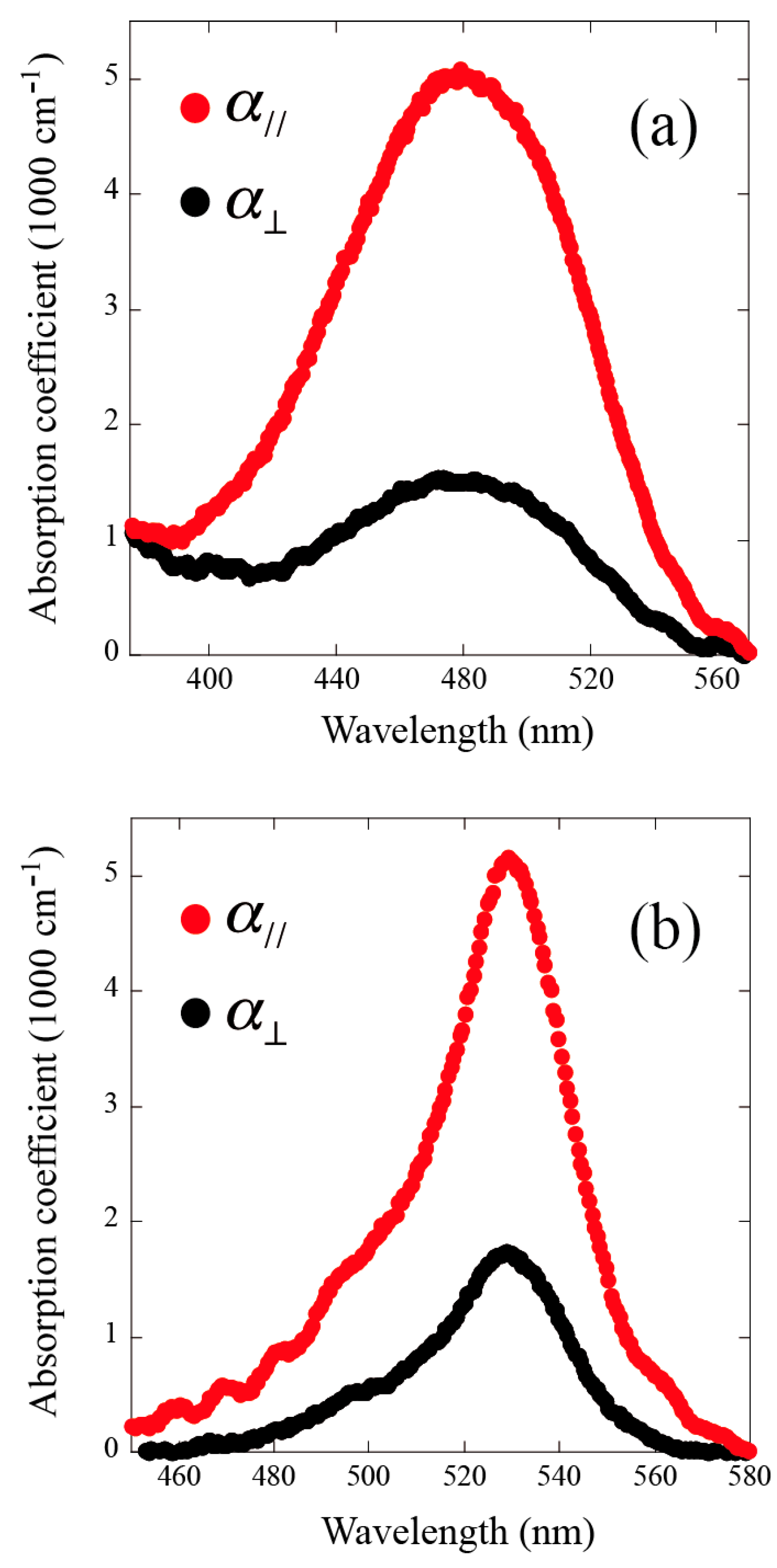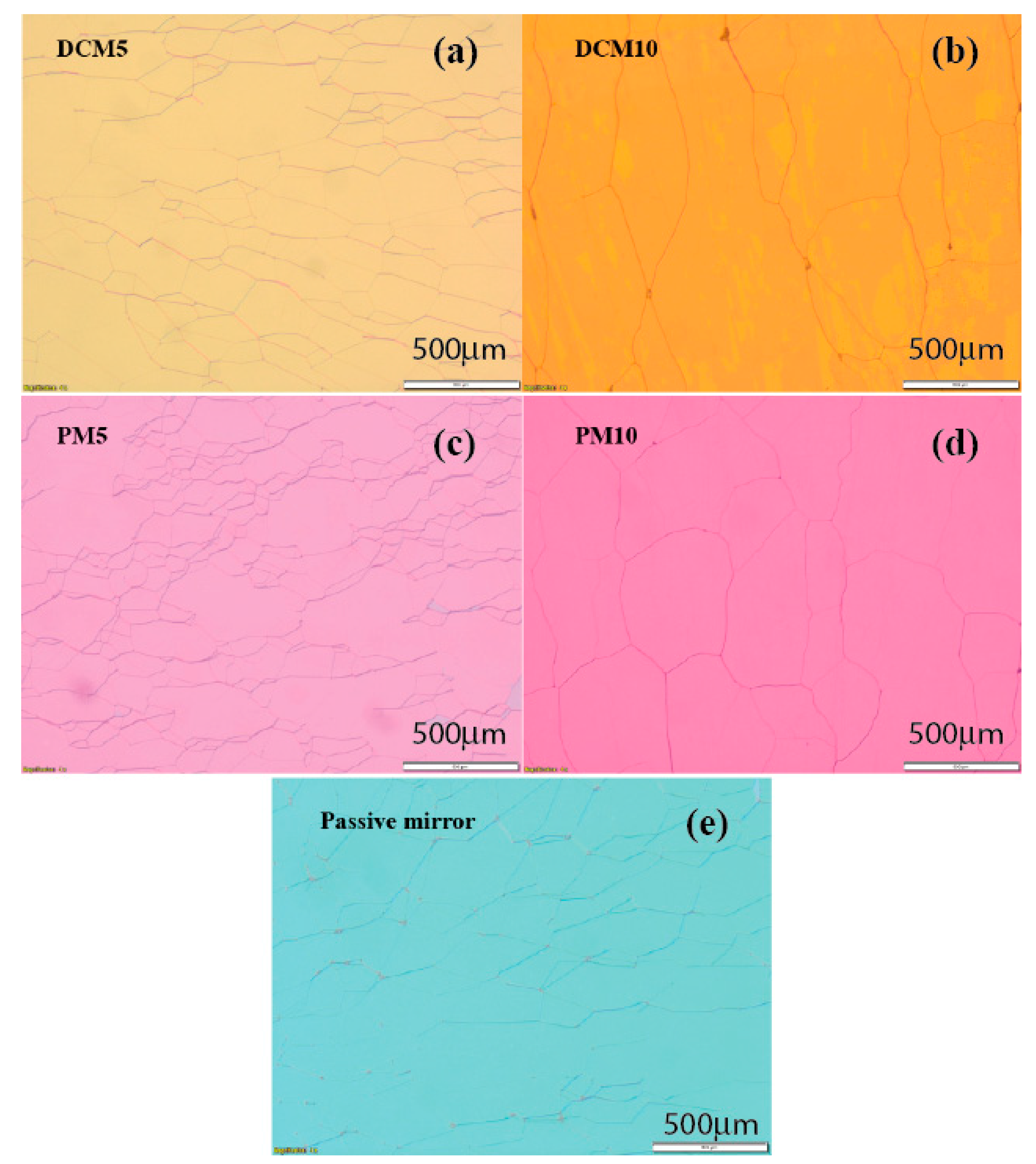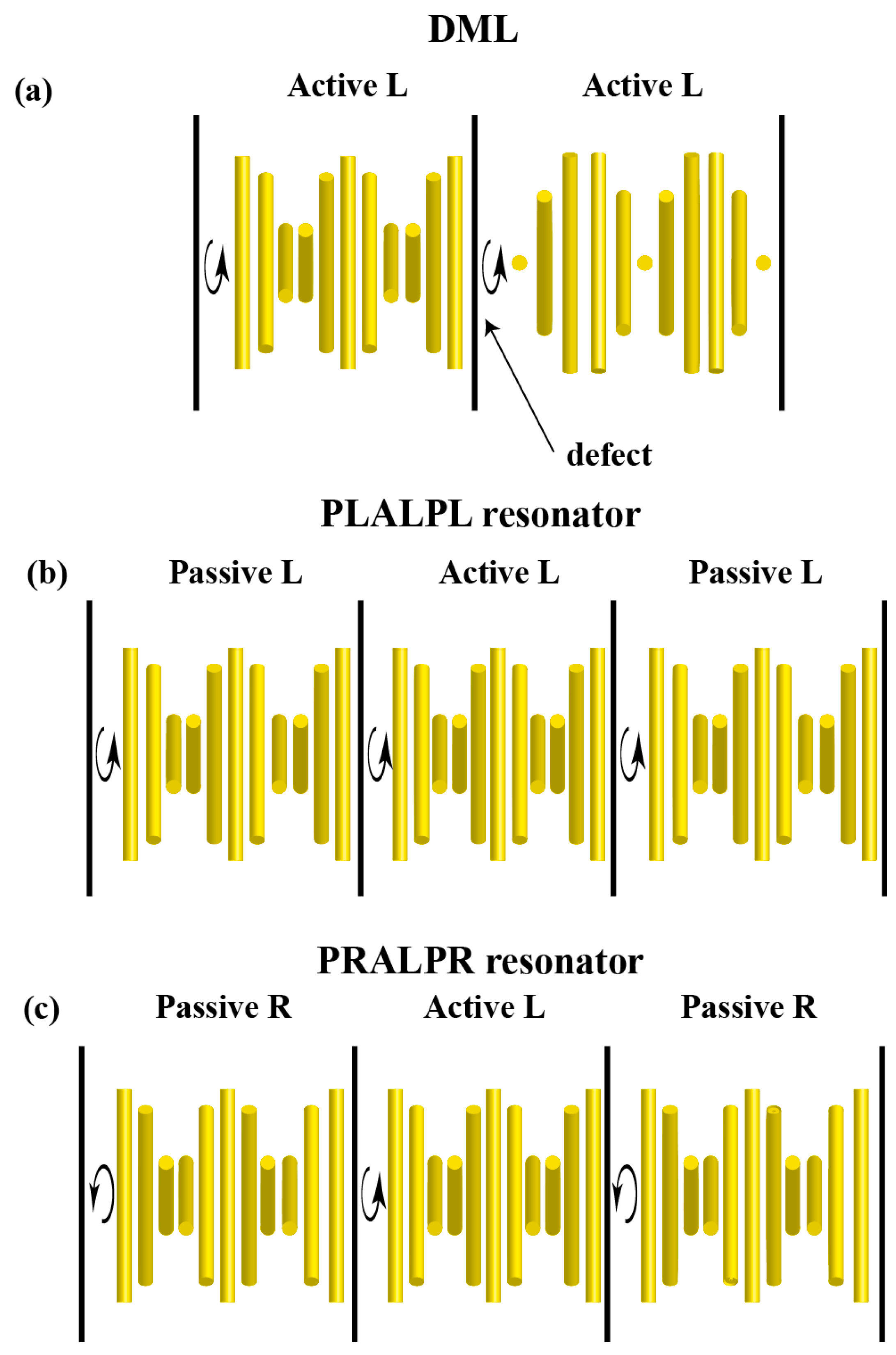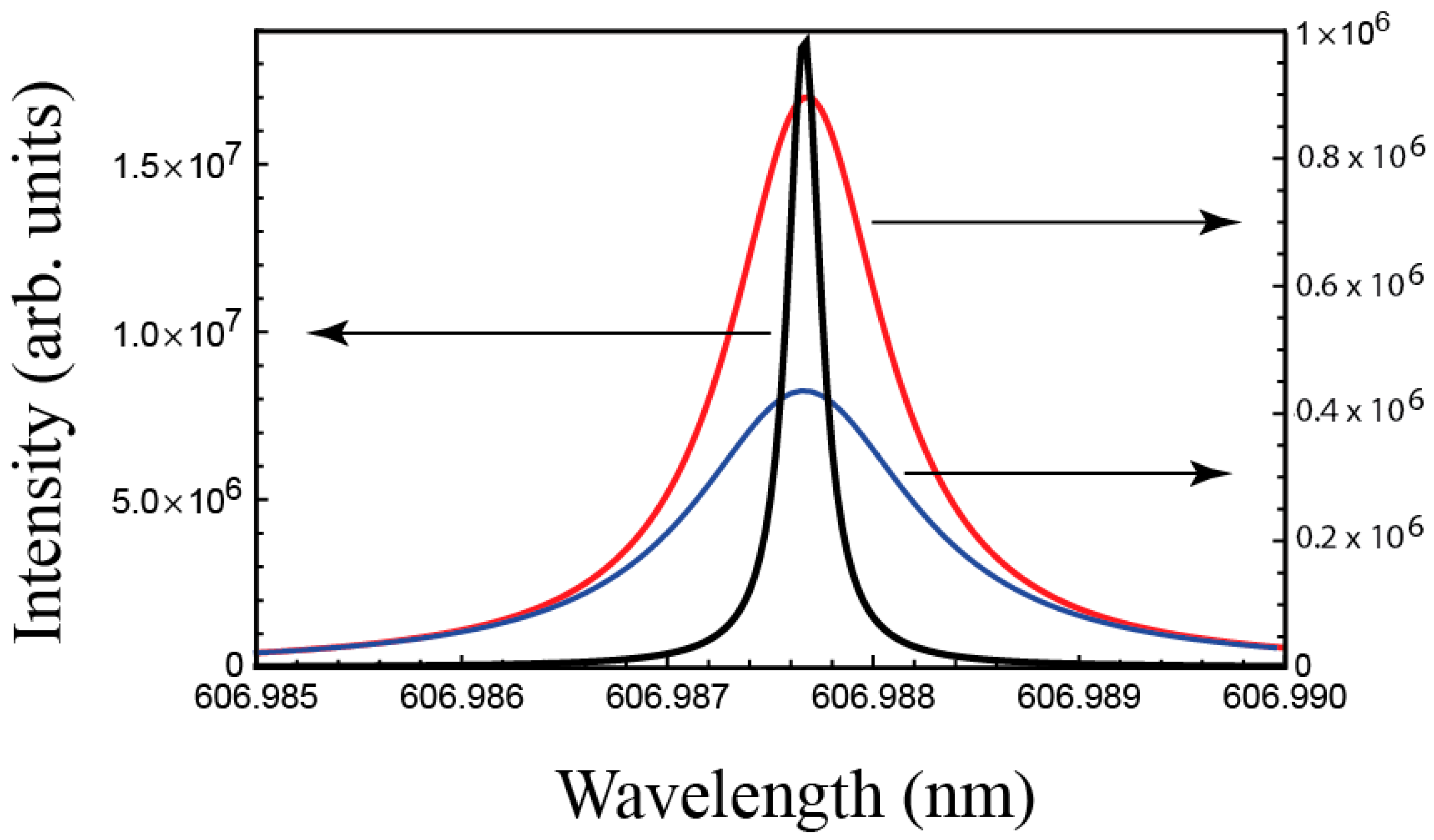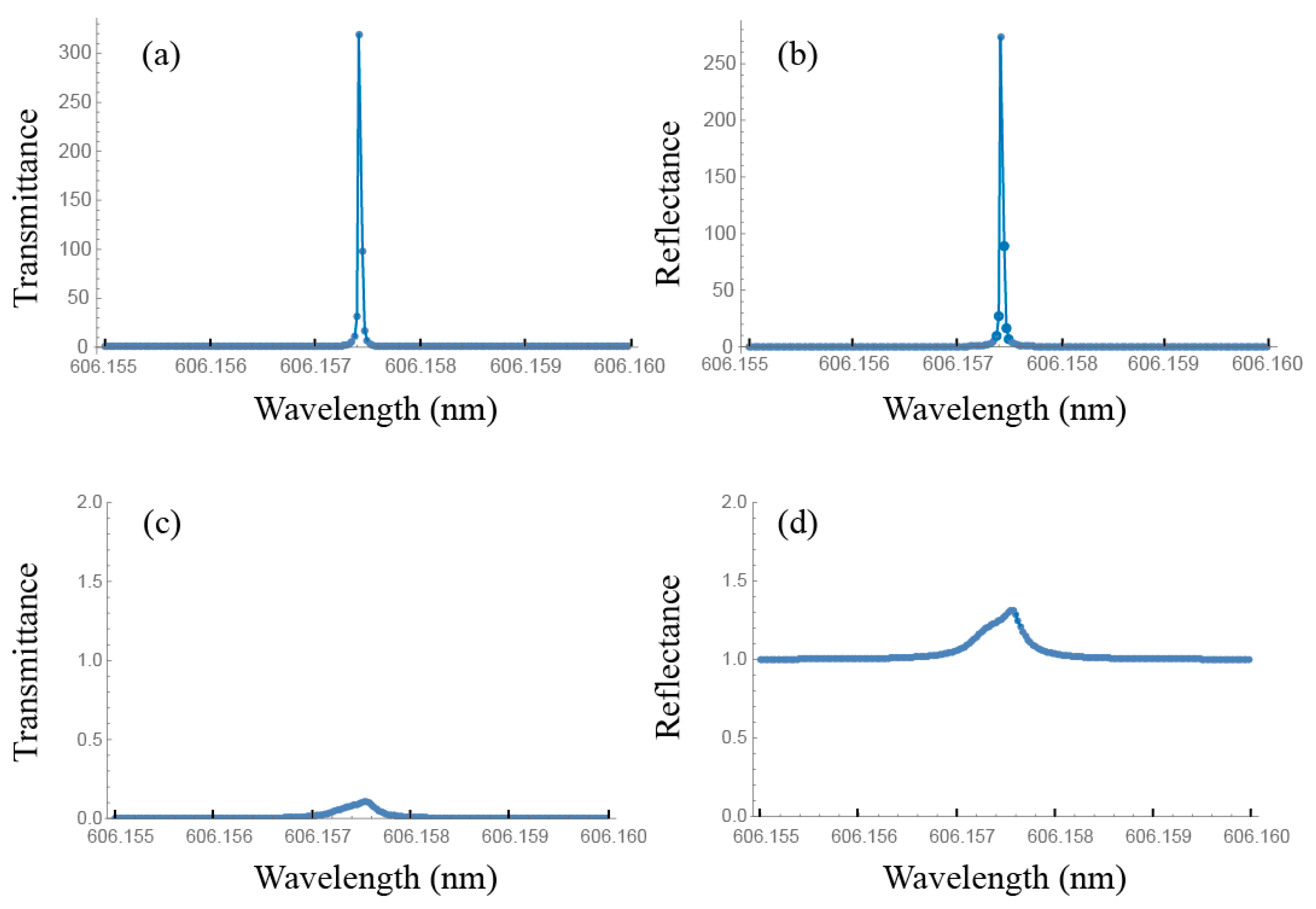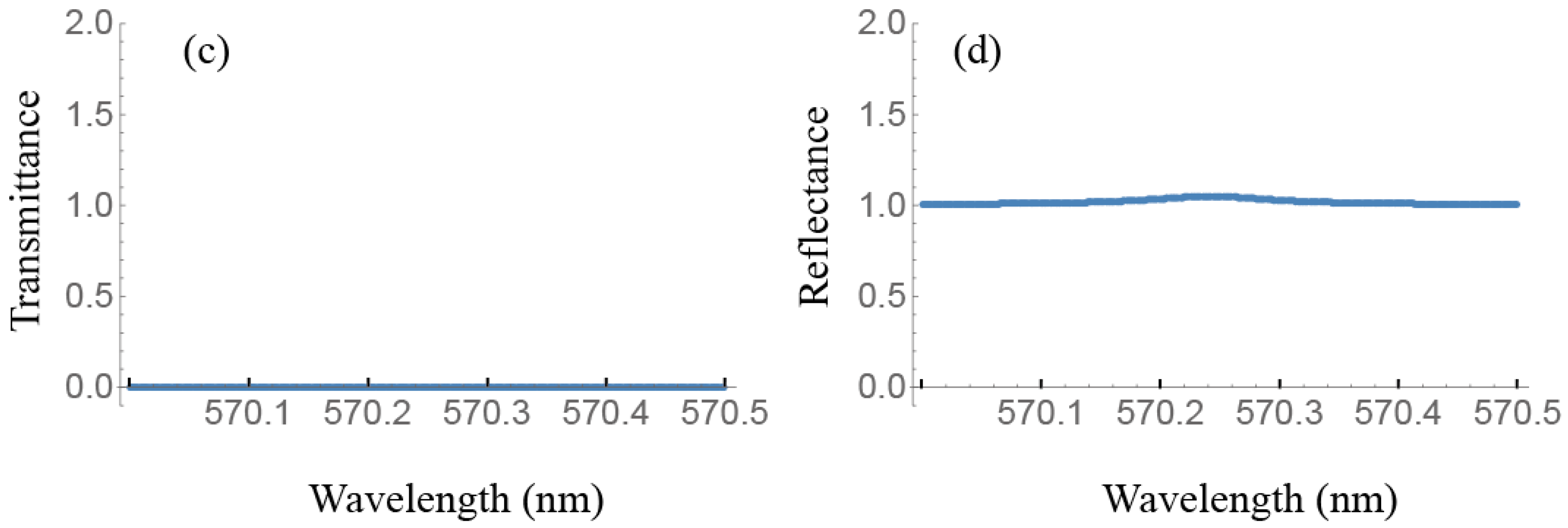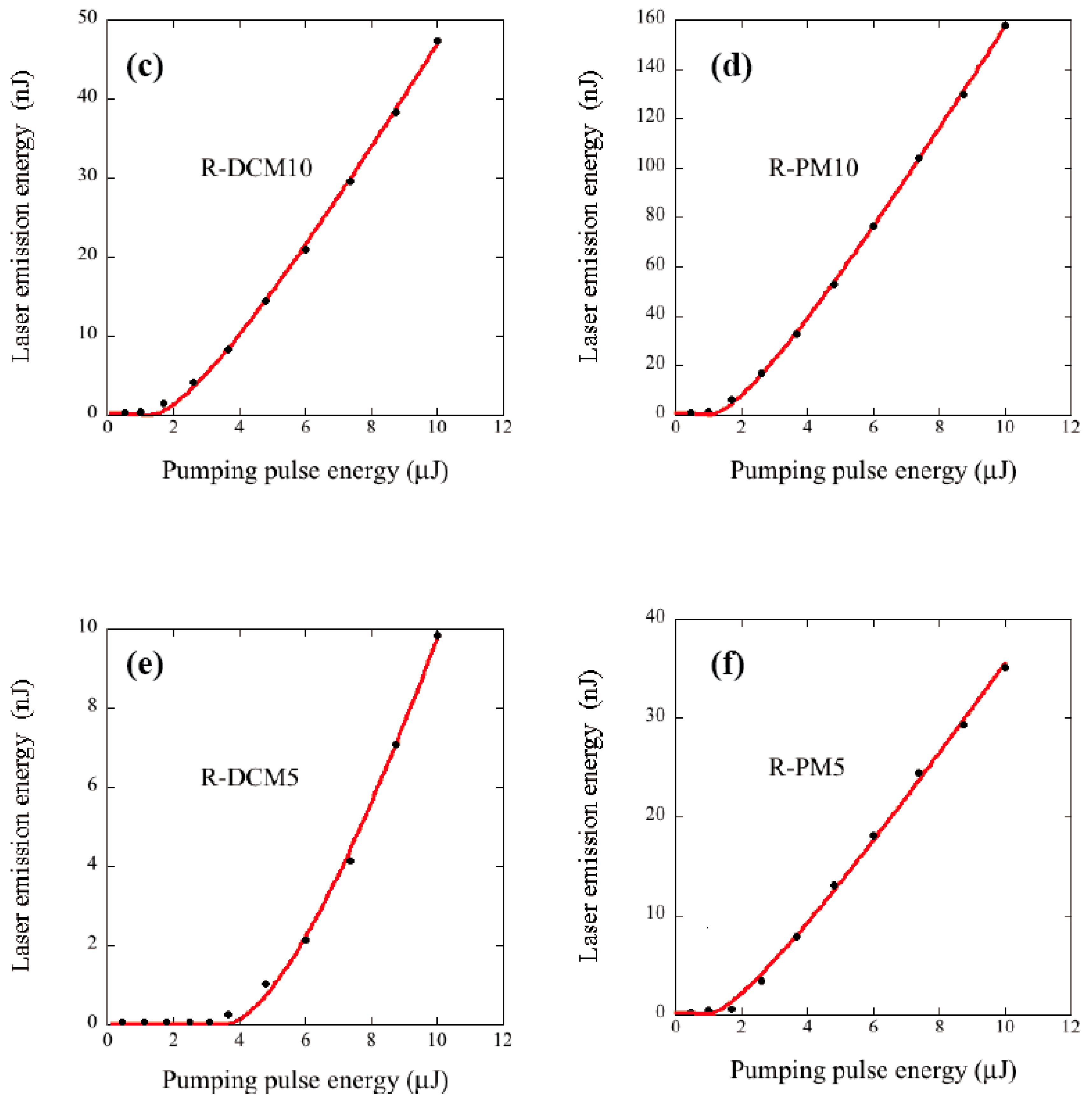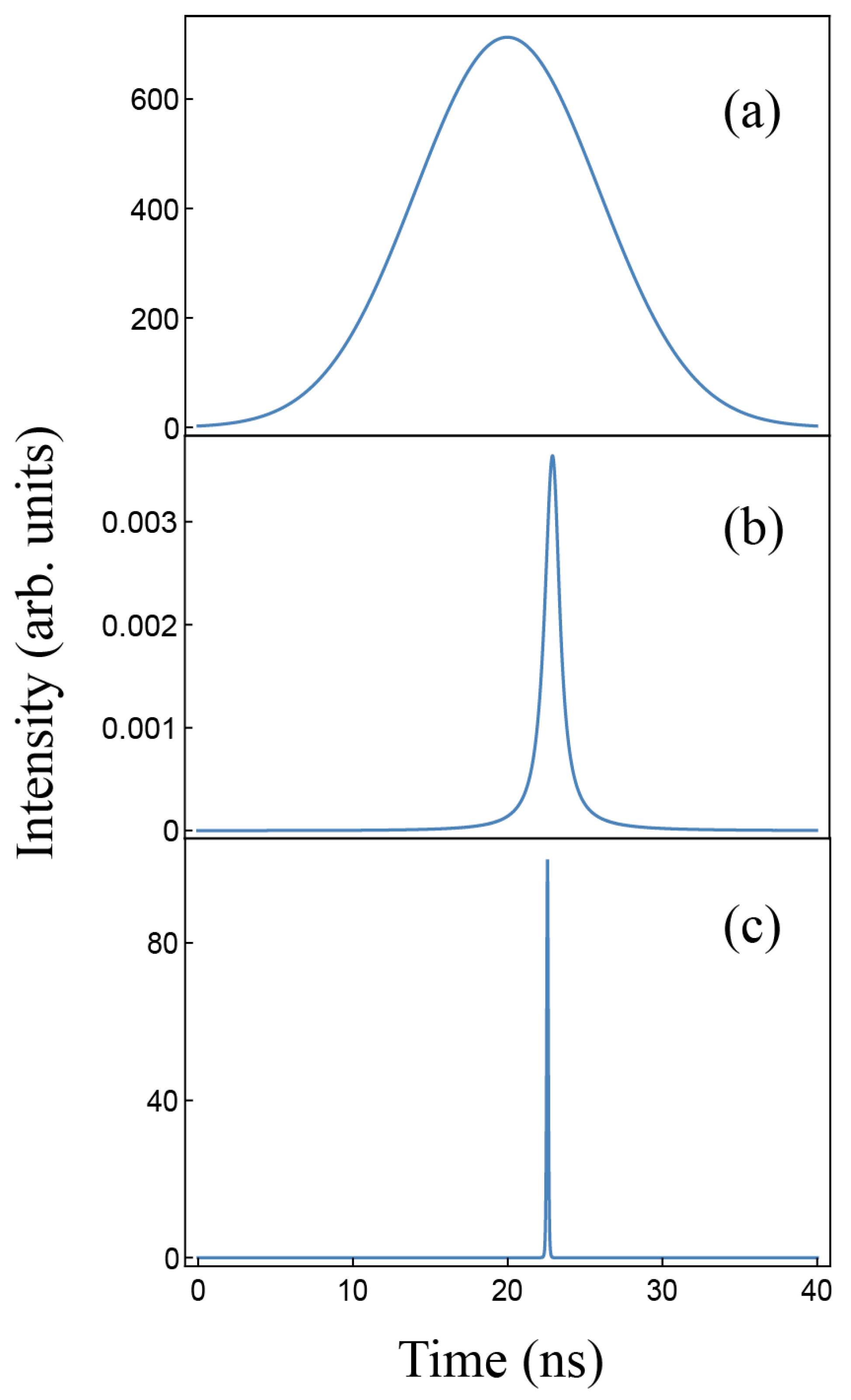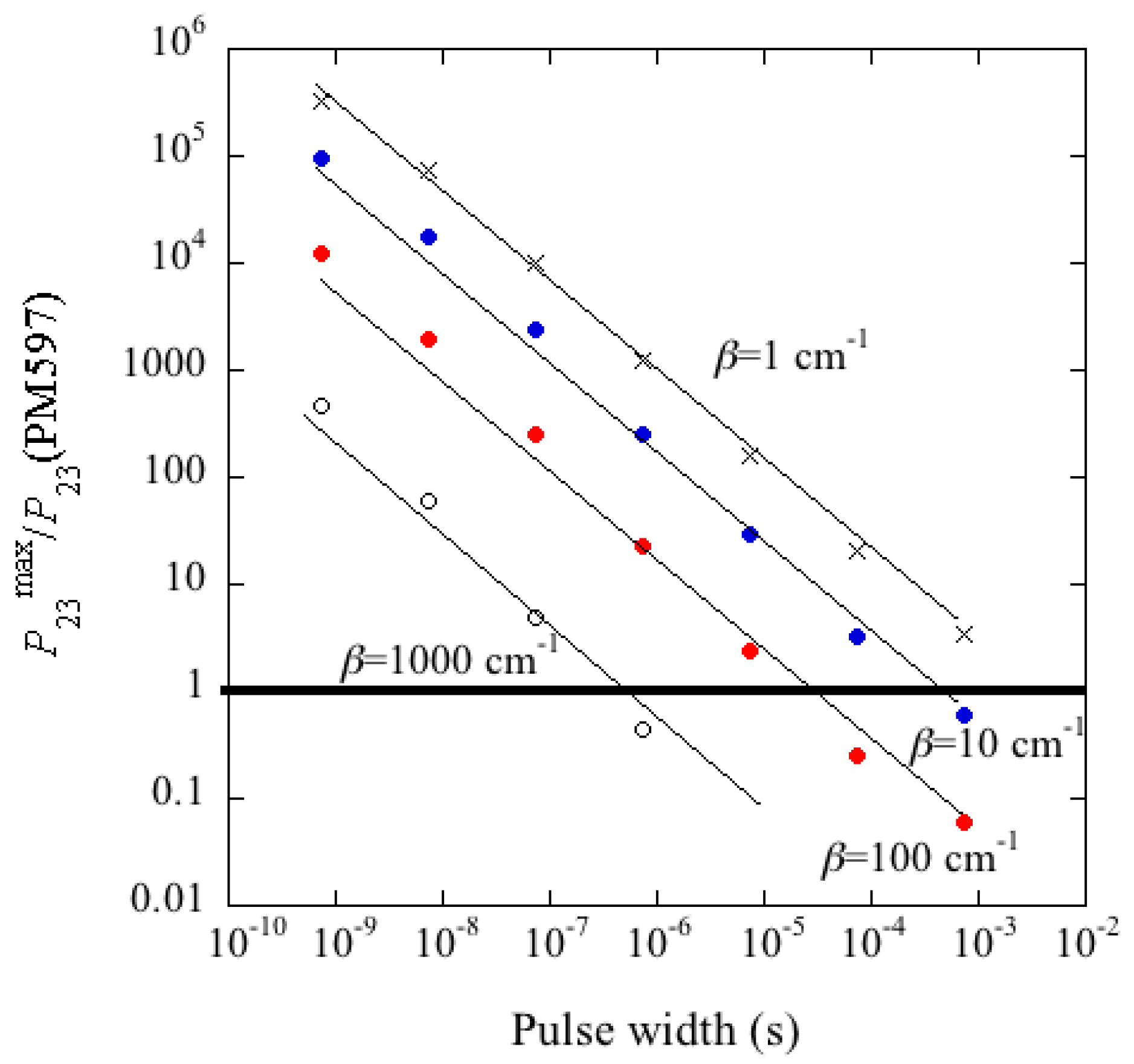1. Introduction
In cholesteric liquid crystals (CLC), molecules are self-assembled forming a helical structure. When the pitch of the CLC helix is of the order of magnitude of visible light wavelength, the material can exhibit photonic properties. In these cases CLCs present a photonic band gap (PBG), and circularly polarized light with the same handedness as that of the helix cannot propagate in a certain range of frequencies. The photonic character of CLCs is the basis for the application of these materials as low-threshold distributed feedback (DFB) lasers. In fact, when CLCs are doped with fluorescent dyes, mirrorless laser generation can be obtained at the edges of the PBG. Since the discovery of laser emission in CLCs by Kopp et al. in 1998 [
1], many efforts have been made to build up CLC lasers with increasing performance and durability [
2,
3,
4,
5,
6,
7,
8,
9,
10,
11,
12,
13,
14,
15,
16].
Apart from liquid crystal (LC) lasers based on the self-assembled helical structure, there are other DFB laser types grounded on artificially designed structures such as gratings [
17,
18,
19,
20]. On the other hand, CLCs have also been used in connection with other laser mechanisms such a leaky mode lasers [
3] and random lasers [
21,
22,
23], and references therein. However, in the present work we are going to focus ourselves exclusively on the so-called edge-mode and defect-mode CLC lasers.
The main features that make CLC lasers so attractive are the ease of fabrication that permits to obtain miniaturized devices, the low threshold intensity, and the possibility of tuning the wavelength by using different emission angles [
24], pitch gradients [
25,
26], or external stimuli such as electric field application [
27,
28,
29,
30], light irradiation [
31,
32,
33], mechanical stretching [
34] or temperature [
35,
36].
However, in order to manufacture small laser devices economically and at great scale it is indispensable to further improve their performance. One of the key points is reducing the threshold of the pumping energy required for laser emission, since it would permit using simpler pumping sources. Up to now, pumping sources have always been bulky high-power pulsed lasers with pulse duration in the range of nano- to pico-seconds.
One of the most effective strategies to reduce the pumping threshold energy is the use of multilayer CLC cells. Some of these architectures are based on the so-called defect mode laser (DML). The possibility of lasing originated by defects was theoretically predicted in several works [
37,
38,
39,
40,
41]. Although the concept of DML is used in a broad sense in the literature, hereafter we will refer to it as the laser mode that appears when a dye-doped CLC layer presents a structural distortion. We will pay special attention to the case of a phase jump in the twisting angle of the LC director as we move along the helix axis (see
Figure 1a). The DML presents in general a lower threshold than that of the edge mode (EM) of the undistorted structure. In this respect Schmidtke et al. [
42] reported a reduction of about one order of magnitude in the laser threshold by stacking two layers of cholesteric polymer films with a phase jump of π/2. A decrease of about one fourth of the threshold energy was also reported by Jeong et al. [
43] in a cell formed by two dye-doped polymeric-CLC films with a thin rubbed defect layer in between. Other studies concerning irregularities in the helical pitch have been also carried out and, also in these cases, the DML has shown a lower threshold than that of the corresponding EM [
44].
An alternative to the DML approach is the use of other types of multilayer cells, usually three layers, in which the two external films act as reflectors. The laser modes that appear in these cell architectures are also considered in the literature as defect modes. However, in most of the cases, the external films are inactive and only the internal layer is dye-doped. Therefore, the role of the reflectors is similar to that of the mirrors in Fabry-Perot cavity lasers. This strategy has been used in many different ways: In some cases two polymeric CLC passive structures sandwiching a dye-doped nematic or isotropic layer [
45], in other cases, an active polymeric CLC film placed between a conventional mirror and a CLC passive structure [
46]. Other possibilities include the case of an active CLC layer inserted between two CLC passive layers of the same handedness (
Figure 1b) [
47], or of the opposite to the one of the active film (
Figure 1c) [
48]. In all previous cases, polymeric CLC’s were used to achieve a good optical contact between the different layers. In order to avoid the laborious construction of polymeric structures and further simplify the construction of complex cells, Zhou et al. [
49] stacked different low-molecular CLC mixtures by using standard glass cells. In this case, a remarkable improvement in the quality of the laser cavity was also found.
The previous studies present, in general, important improvements in the quality of the laser cavities. However, in some cases the threshold energies were compared to simple active CLC films with poor performance or, in other cases, important parameters such as the pumping energy fluence at the laser threshold could not be easily derived from the published data. Therefore, it is interesting to find a tool to compare the quality of different cell architectures in a systematic way. This is important to determine the most efficient strategies to obtain low threshold CLC lasers.
The ultimate target in the improvement of CLC-laser capabilities is to develop continuous wave (CW) lasers. The achievement of this objective presents two important difficulties. On the one hand the CLC materials cannot dissipate easily the energy flux due to the high pumping fluence required for lasing. On the other hand the existence of a triplet state in the dyes prevents to maintain laser action continuously. Only a work by Muñoz et al. [
50] reported the fabrication of a CW laser by using a polymer-stabilized CLC with a pitch gradient across the cell thickness. However, the temporal coherence of the laser emission was very poor and laser emission was hardly distinguishable from amplified spontaneous emission (ASE).
The main aim of this work is to analyze the different strategies used for the optimization of CLC laser cavities indicating some possible fields of improvement and pointing out the limitations of some of the strategies used so far. Firstly we will carry out comparative studies of different cell architectures from a theoretical point of view. Surprisingly, apart from studies in simple CLC cells [
51,
52,
53,
54], a detailed treatment of the laser characteristics in complex structures is still lacking in the literature and, up to now, only qualitative or semiquantitative aspects based on the concept of density of states (DOS) are normally considered. This problem will be treated in
Section 2 using standard numerical methods, but incorporating some novel aspects in the calculations to properly quantify the performance of the different sample architectures. Next, the most promising cell designs will be experimentally tested to confirm the theoretical results. For this purpose eight different CLC samples will be thoroughly measured. In addition, we will present some new results about the prospects for CW lasers regarding the maximum achievable pulse width, and its dependence on the properties of the dye. Finally, we will draw some conclusions about the possibilities and limitations of the CLC lasers in general.
2. Theoretical Analysis of Different Cell Architectures
We carried out a study of different kinds of cells by using the 4 × 4 matrix transfer formalism developed by Berreman [
55]. This approach can be applied to the case of stratified anisotropic media. We mainly focused on CLC-active cells sandwiched within two passive CLC layers acting as reflectors although other cell configurations were also studied. In our studies, the photonic band gap (PBG) of the two passive CLC layers overlaps the long-wavelength PBG edge of the active CLC layer in order to obtain the desired reflecting effect. We studied both the cases of reflectors with the same handedness as that of the active layer and with the opposite one. For the sake of completeness, the case of DML was also briefly treated.
Under the Berreman method, the case of an amplifying medium can be implemented by using a complex dielectric tensor at each layer with a negative imaginary part. This imaginary part is achieved through the pumping, which gives rise to a population inversion in the dye molecules permitting then light amplification. We used an approximate expression for the local dielectric tensor of the form:
where
and
are the components of the dielectric tensor parallel and perpendicular to the local director for optical frequencies,
and
are the corresponding ratios of the imaginary and real parts of the dielectric tensor, and
and
are the real extraordinary and ordinary refractive indices of the material. In the expression we have neglected the contribution of the extinction coefficient to the real part of the dielectric tensor. We have also assumed that the dispersion of the refractive indices in the optical frequency range is null.
In our calculations we will assume that the gain anisotropy is similar to that of the absorption coefficients. This point can be justified since both the local absorption coefficient and the gain are connected to the orientation of the transition dipole moment of the dye in a similar fashion. For the calculations we will take the ratio
as in the case of the mixture of the classical nematic liquid crystal E7 and the dye 4-(dicyanomethylene)-2-methyl-6-(p-dimethylaminostyryl)-4H-pyran (DCM), in the proportion: 99:1 (wt %) at room temperature (see
Appendix A). Thus, only one parameter,
, determines the amplifying features of the medium.
Under amplifying conditions the reflectance R and transmittance T fulfill the condition T + R > 1. For a critical value
, the total output intensity diverges at a given wavelength. This is the situation for which laser emission occurs. For higher
values, lasing does not occur anymore (see
Figure 2). Therefore,
is the parameter to be calculated in order to determine the lasing features of the sample. Belyakov and Semenov [
56] obtained analytic expressions for the critical values
corresponding to the different EM’s in the case of a simple CLC layer. However, under not too strong pumping conditions, lasing takes place only at the wavelength that presents the lowest
value, so we will calculate exclusively this quantity. In our case, the complexity of the multilayer cells prevents us from obtaining simple analytic expressions for
so we determined it numerically. The lasing wavelength was in all cases close to the long-wavelength edge of the PBG of the active medium. This was expected since we took
.
The calculation was performed under the condition that the incident and transmitted waves had the same polarization state. This provides two different solutions, i.e., two different eigenstates of transmission. Then, we used these eigenstates as input lights with intensity value equal to unity, and found the parameter that gives an output intensity spectrum characteristic of laser emission. We observed that only one of the two eigenstates promotes laser emission at a given wavelength. Hereafter we will refer to it as a laser eigenstate.
Next we are going to relate
with physical parameters easier to interpret. As previously mentioned, active media are obtained by doping CLCs with dyes. Typically, organic dyes present a structure of three effective electron bands as shown in
Figure 3. Bands 1 and 2 are singlets and represent the ground and the excited states respectively. Number 3 is the ground triplet band. The densities of population of dyes at each band are denoted as
n1,
n2 and
n3. Transitions represented with dashed lines inside the bands are very fast and purely non-radiative. As a consequence, population inversion takes place between the lowest energy level of band 2 and the highest energy level of band 1.
and
are the rates of induced transitions from 1 to 2 or 2 to 1, absorbing or emitting one photon respectively.
represents the rate of spontaneous transitions from level 2 to 1 by emission of one photon, and
and
are the rates of intersystem crossing processes between levels 2 and 3, or 3 and 1 respectively. Transition
is also non-radiative.
When a dye-doped medium is pumped with an external source, a certain density of population in the excited state 2 is achieved. In this case, the medium can amplify an electromagnetic wave travelling through it due to stimulated emission. The transmittance corresponding to an eigenstate of the electromagnetic wave in the amplifying medium is given by:
where
σe is the emission cross-section of the dye for the corresponding polarization eigenstate,
L is the sample thickness and
n2 is the density of dye population in the excited state. When lasing takes place
n2 remains almost constant. The corresponding value will be denoted as
. This quantity represents the density of population of excited dyes required for lasing and is a good indicator of the quality of the laser cavity, i.e., the lower the value of
the better the quality of the cavity. Our main aim in our calculations was to determine this quantity for the different cell architectures.
can be obtained from
as follows: From Equation (1) the extraordinary complex refractive index
for weakly amplifying media is given by:
On the other hand, comparing Equations (2) and (3) the following equation can be easily deduced:
where
λ is the vacuum wavelength of the electromagnetic field that is amplified. Therefore, it is straightforward to obtain
by using Equation (4) for lasing conditions, i.e.,
where
λ, in this case, is the laser wavelength. Although
does not determine completely the threshold pumping energy required for lasing, since it takes into account neither the dynamical aspects of the laser process nor the way the pumping light is absorbed, it is useful for comparing the quality of the different cell architectures to each other.
For the simulations we use the optical data listed in
Table 1. These parameters are typical of CLC’s and are, in fact, quite similar to those of one of the compounds we have studied experimentally (see
Section 3).
The different types of cells we have examined will be denoted as follows: AL5 or AL10 means simple left handed active CLC samples of 5 and 10 μm thickness respectively. In our study, the passive reflectors thickness is in all cases 5 μm and the helical pitch 370 nm. We have examined left and right handed passive CLC layers that will be denoted as PL and PR. According to this nomenclature, for example, an active layer of 5 μm thickness sandwiched within two left-handed reflectors is denoted as PLAL5PL.
As an example we show in
Figure 4 the emission spectrum corresponding to the cell PLAL10PL.
Figure 4a,b show the transmitted and reflected intensity spectra for the laser eigenstate. They represent the emission intensities that emerge by both external faces of the cell. In general the polarization eigenstate is elliptically polarized. When lasing takes place, both intensities are almost equal due to the symmetry of the cell. It is remarkable that the laser emission wavelength corresponds to that of the low energy edge of the PBG of the active layer. As the laser line is very narrow, only a small range of emission wavelengths is depicted.
Figure 4c,d are obtained with the non-diffracting eigenstate input. In this case, no lasing is observed. Our calculations also permit to obtain the polarization of the light eigenstates inside the sample. We have observed that the polarization of the laser eigenstate in the active layer is linearly polarized along the local director.
Table 2 gathers the results for
and
in different types of cells.
/N (%) is the percentage of the dye population in the excited state required for laser emission relative to the total number of dye molecules. In the case of simple cells approximate analytical expressions for
have been given in the literature [
56,
57]:
According to the results in
Table 2 it is clear that the use CLC passive layers acting as reflectors improves very efficiently the quality of the laser cavity. In fact, the
values are reduced in several orders of magnitude respect to the case of the corresponding CLC active sample without reflectors. Some of these figures for
cannot be reached with simple cells unless unrealizable thicknesses or birefringences are assumed (see Equation (6)). The complex cells with CLC reflectors, with the same handedness as that of the active layer, present the highest quality. In fact, the case of PLAL10PL presents a
value so small that laser is expected to be almost thresholdless.
In the case of CLC passive reflectors with opposite handedness as that of the active layer, it is clear that the improvement of the quality of the laser cavity is worse. This point is easy to understand since in this case, the reflectors act as in a Fabry-Perot for the circular right-handed polarization state. Therefore, the active CLC layer does not play the role of an advantageous photonic structure. In this respect, a smaller would be expected if the active layer were replaced simply by an isotropic material, since, in this case, losses would be smaller. The irrelevance of the active photonic structure is evident in our results since the quality of the laser cavity is similar in the cases of PRAL5PR and PRAL10PR.
We have also considered the case of complex cells in which the different layers are separated by thick glasses (~2 mm). These cell arrangements are interesting in practice because they can be constructed very easily by simply stacking different standard glass cells that contain the required CLC structures. In all cases the modes corresponding to the lowest present similar values to those of cells without the glasses.
We finally treat the case of DML, where a phase-jump in the twisting angle of the LC director appears at a certain point of the helical structure, as in
Figure 1a. According to the reported experimental results [
42,
43], laser emission corresponding to these modes presents a lower threshold than that of the EM of the non-distorted structure. In practice, this kind of defects can be induced by coupling two active CLC layers, usually polymeric structures, with a controlled phase-jump in the LC director at the coupling interface. Following the Berreman formalism, as in the previous cases, we have studied the gain values required for laser emission corresponding to the defect modes. We have observed that the laser wavelength depends on the phase jump angle of the defect and the corresponding
value is somewhat smaller than that of the PBG edge mode. In the case of a left handed CLC sample of 10 μm thickness with a defect mode of angular jump of π/2 in the middle of the sample (DML10) (see
Figure 1a) the gain value is about one third the value of the edge mode of the non-distorted structure (last line in
Table 2).
Figure 5a,b show the transmitted and reflected intensity spectra of the laser mode and
Figure 5c,d that of the non-diffracting eigenstate. It is remarkable that the polarization of the laser is right-handed elliptical. For a sample of 20 μm of thickness with a similar defect, the polarization is roughly right handed circular in agreement with the results obtained by Schmidtke et al. [
42]. The laser wavelength due to the defect mode can be tuned all over the entire range of the PBG by changing the angular jump from 0 to π. In the case of a phase jump of π/2, laser takes place at the wavelength just in the middle of the PBG.
In view of the general trend of the results in
Table 2, one could draw the conclusion that a higher level of sophistication in the structures of the laser cavities could lead eventually to a situation of thresholdless lasing, which would be appropriate for designing CW lasers. However, we will see now that the expression for
must be corrected in a non-trivial fashion to give account of the losses in the cavity due to light scattering or absorption.
In principle,
is related to the dwelling time
τc of laser photons in the cavity in the absence of losses by means of the expression [
57]:
where
n is an average refractive index and
c the speed of light in vacuum. These are the
values shown in
Table 2. Nevertheless, Equation (7) and our calculations disregard the pernicious contribution of the losses in the cavity (scattering and absorption) that are always present in CLC materials. If we take into account these losses, the expression for
is corrected as [
54]:
where
β is the so-called coefficient of distributed losses. We will see that for very high-quality laser cavities, as is the case of complex layers with passive reflectors, the lowest limit for
is almost exclusively determined by the value of
β. As a numerical example we estimate the case of the cell PLAL5PL. From
Table 2 and
Table A1,
n/cτc =
σe = 1.6 cm
−1. As will be shown below, this quantity is much smaller than typical
β values, which are in the range of 100 cm
−1 (see
Appendix A and
Section 3 for experimental
β values). Then, from Equation (8), we deduce that it is pointless to try to reduce the “theoretical”
by means of complicated cavity designs, because, in practice,
is limited by the scattering and absorption losses. The simple consideration of the molecular orientation fluctuations, intrinsic in mesogenic phases, already gives rise to enough scattering of light so as to spoil any “highly-developed” CLC laser cavity. We will come back to these ideas in the experimental part of the paper.
We finish this section by giving a link between
and the threshold energy per pulse
Eth in order to compare the previous theoretical analysis with experimentally measurable quantities. In the case of nanosecond or picosecond pump pulses, an approximate analytical expression for
Eth was obtained by Sanz-Enguita et al. [
10]
where
h is Planck’s constant. This equation was deduced from the kinetic equations of the excited state populations of dyes and emitted light developed by Shtykov and Palto [
40]. In Equation (9)
υa is the pumping light frequency,
S is the pumped area,
L the active sample thickness, ∆
τp is the pumping pulse duration,
τf is the fluorescence lifetime,
σa is the absorption cross-section for the pumping radiation, and
the dye population density in the ground level at the threshold. The expression can be applied to any laser cavity provided that the energy level scheme of the dyes is that of
Figure 2.
Eth is roughly proportional to
, as expected. This equation will be used to account for the results obtained in the next experimental section in which some CLC simple cells will be studied together with the complex cells that are expected to present the lowest
Eth, i.e., the cases of cells PLAL5PL and PLAL10PL. The experiments will be carried out using two different dyes.
